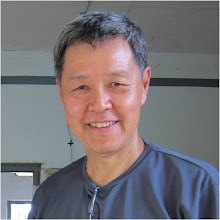
The Japanese ethnic group is deceptively homogeneous.The dominant ethnic group however is recognizable as the Yamato people. These are whom we have come to commonly recognize as 'Japanese'. However, some minor ethnic groups do find their home in Japan. Apart from the obvious transplants such as Koreans, Chinese, Taiwanese etc, these are the Ainus, Ryukyuans and the Nivkhs.
The Yamatos are people who derive originally from the North Chinese mainland, having crossed over through the Korean peninsula. Consequently, there is a genetic thread that runs through and links the Northern Han Chinese and Koreans with the Yamato Japanese. By contrast the Ainu and Ryukyuans are earlier peoples who antedate the arrival of the Yamato people. RIKEN has data that show the genetic similarity between the Ainu and the Ryukuans (Okinawans). It is thought that the arrival of Yamato cleaved the distribution of the original Austronesian population to create a northern Ainu group and a southern Okinawan group. The Nivkhs are a small minority who derive from Siberia.
That said, the Japanese are pretty much of the Yamato group (>98% of toal 130 million). The Ryukuans probably account for about 1% and the Ainu even less (0.3%).
From a practical perspective, when one examines Japanese PGx data we should make mental links with data originating from Northern China and Korea. Accordingly, some caution is necessary when we try and connect the dots between Japanese and essentially Southern Chinese and South East Asian data.
The following excerpted from Wikipedia (Japanese_people):
A recent study for the origins of Japanese people is based on the "dual structure model" proposed by Hanihara in 1991. He concludes that modern Japanese lineages consist of the original Jōmon people and immigrants from the Yayoi period. The Jōmon people originated in southeast Asia, moving to the Japanese Archipelago in the Palaeolithic period. In past several decades, the Japanese people was proposed to relate to Yi, Hani and Dai people based on folk customs or genetic evidences.
Another southeast Asian group moved to northeastern Asia. The population of this group increased in the Neolithic period and some moved to the archipelago during the Yayoi period. The miscegenation prevailed in Kyūshū, Shikoku and Honshū islands but not in Okinawa and Hokkaido, respectively represented by the Ryukyuan and Ainu people. This theory was based on the study of the development of human bones and teeth. The comparison of mitochondrial DNA between Jōmon people and medieval Ainu also supports the theory.








No comments:
Post a Comment